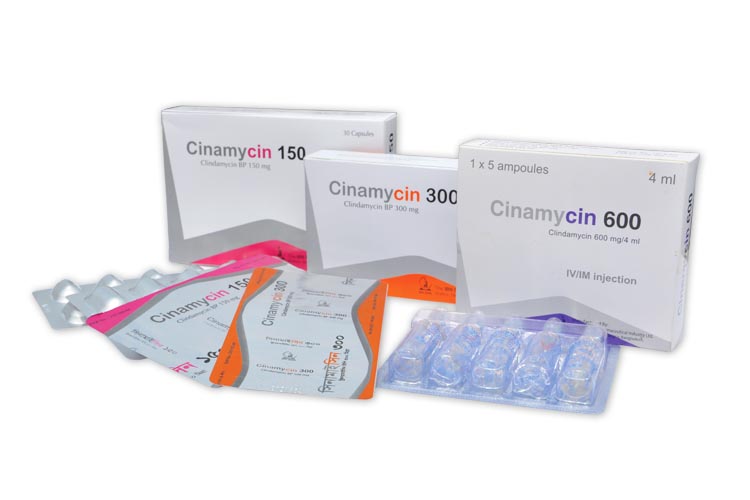
CINAMYCIN
CLINDAMYCIN HYDROCHLORIDE BP
| NAME | STRENGTH | PACK SIZE | DOSAGE FORM |
|---|---|---|---|
| CINAMYCIN 150 MG | 150 MG | 30 S | CAPSULE |
| CINAMYCIN 300 MG | 300 MG | 30 S | CAPSULE |
Cinamycin 150 Capsule: Each capsule contains Clindamycin Hydrochloride BP equivalent to Clindamycin 150 mg. Cinamycin 300 Capsule: Each capsule contains Clindamycin Hydrochloride BP equivalent to Clindamycin 300 mg.
Clindamycin is a lincosamide antibiotic. It inhibits bacterial protein synthesis by binding to the 50S subunit of the ribosome. It has activity against Aerobic gram-positive cocci, including: Staphylococcus aureus, Staphylococcus epidermidis (penicillinase and non-penicillinase producing strains), Streptococci, Pneumococci. Anaerobic gram-negative bacilli, including: Bacteroides species, Fusobacterium species. Anaerobic gram-positive non-spore forming bacilli, including: Propionibacterium species, Eubacterium species, Actinomyces species. Anaerobic and microaerophilic gram-positive cocci, including: Peptococcus species, Peptostreptococcus species, Microaerophilic streptococci, C. perferinges.
Clindamycin HCl is indicated in the treatment of the following infections caused by susceptible anaerobic bacteria or susceptible strains of gram positive bacteria such as Streptococci, Staphylococci and Pneumococci; Upper respiratory infections, Lower respiratory infections, Skin and soft tissue infections, Bone and joint infections, Pelvic infections, Intra-abdominal infections, Septicemia and endocarditis, Dental infections. As an alternative therapy when used in combination with quinine or amodiaquine for the treatment of multi-drug resistant Plasmodium falciporum infection.
Serious infections: 150 to 300 mg every 6 hours. More severe infections: 300 to 450 mg every 6 hours.
Clindamycin is contraindicated in patients previously found to be sensitive to clindamycin or lincomycin or any of the ingredients of this medicine.
Cinamycin should be prescribed with caution in individuals with a history of gastrointestinal disease, particularly colitis. To avoid the possibility of oesophageal irritation, Cinamycin capsules should be taken with a full glass of water.
The adverse effects have been reported with the use of clindamycin are- abdominal pain, oesophagitis and oesophagial ulcer, nausea, vomiting and diarrhoea, pruritus, skin rashes, urticaria.
Pregnancy Category B. Clindamycin crosses the placenta in humans. Clindamycin has been reported to appear in breast milk (0.7 to 3.8mcg/ml). Therefore, it is not recommended for nursing mothers if not clearly needed.
Clindamycin enhance the action of other neuromuscular blocking agents. Therefore, it should be used with caution in patients receiving such agents. Antagonism has been demonstrated between clindamycin and erythromycin in vitro. Because of possible clinical significance, these two drugs should not be administered concurrently.
Overdosage with orally administered clindamycin has been rare. Adverse reactions similar to those seen with normal doses can be expected, however, unexpected reactions could occur. Haemodialysis and peritoneal dialysis are not effective in removing clindamycin from the serum. Overdosage should be treated with simple gastric lavage. No specific antidote is known.
Store in cool and dry place (below 30°C), protect from light. Keep out of reach of children.
Cinamycin 150 Capsule: Box contains 3X10 capsules in Alu-Alu blister. Cinamycin 300 Capsule: Box contains 3X10 capsules in Alu-Alu blister.
